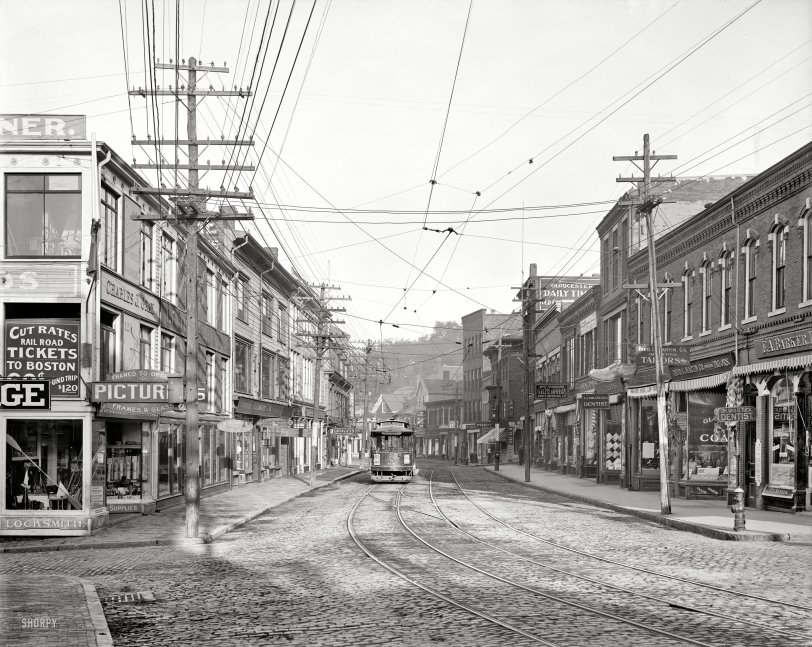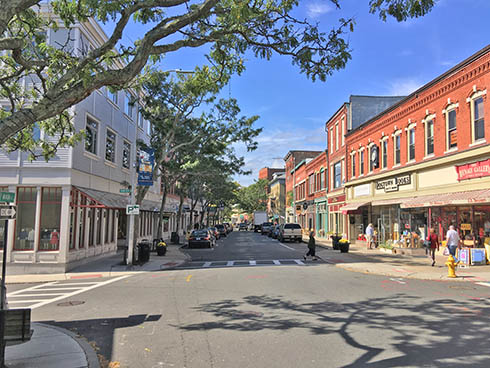


Framed or unframed, desk size to sofa size, printed by us in Arizona and Alabama since 2007. Explore now.
Shorpy is funded by you. Patreon contributors get an ad-free experience.
Learn more.

- Baldwin 62303
- Baldwin VO-1000
- Cold
- No expense spared
- Tough Guys
- Lost in Toyland
- And without gloves
- If I were a blindfolded time traveler
- Smoke Consumer Also Cooks
- Oh that stove!
- Possibly still there?
- What?!?
- $100 Reward
- Freeze Frame
- Texas Flyer wanted
- Just a Year Too Soon
- WWII -- Replacing men with women at the railroad crossing.
- Yes, Icing
- You kids drive me nuts!
- NOT An Easy Job
- I wonder
- Just add window boxes
- Icing Platform?
- Indiana Harbor Belt abides
- Freezing haze
- Corrections (for those who care)
- C&NW at Nelson
- Fallen Flags
- A dangerous job made worse
- Water Stop
Print Emporium
Main Street: 1910

August 1910. "Main Street, Gloucester, Massachusetts." The sidewalks and signage of a century ago. Detroit Publishing Company. View full size.
How it looks today
Took a drive over to Gloucester and did my best to recreate the shot as it looks today.

Trolley or Folly?
Here in Schenectady, NY, the Broadway trolleys were subsidized by General Electric, Whose base of ops was here for almost 100 years. They paid to bring their employees to work every day. Perhaps many other large industries carried the costs of operation for trolley service in some citys?
New lease on life for the giant shotgun!
Seven, eight years later, during the World War, the giant shotgun could be put into service as an antiaircraft gun, should any stray German zeppelins show up in the skies over Gloucester.
A really big shoe
I only I could time-travel just long enough to grab that giant shoe and bring it back to 2010 with me. I am having the worst case of covetitis ever. I would love to live in a room filled with dozens of those old giant replicas of the merchants' actual products.
Barker's Shore Cod Liver Oil
Canadian Journal of Medicine and Surgery, Volume 8, 1900Barker's Shore Cod Liver Oil.
This oil is taken from fresh livers of the codfish caught off the New England coast and brought in by fishermen every day. It is prepared at Gloucester, Mass., which is the largest fishing port in the United States.
In preparing the oil the livers are all picked over and washed, only the healthy livers being used; the unhealthy livers are discarded and used in the manufacture of ordinary grades of cod liver oil.
Barker's Shore Cod Liver Oil has a light straw color but little taste, and is as sweet as the best olive oil. The usual method of making cod liver oil is to allow the livers to accumulate from two to three days to two or three weeks before expressing the oil, all kinds of livers being used. Oil thus obtained has a strong fish odor, is repulsive to the taste and stomach, and has done much to discourage the use of cod liver oil. …
Barker's Shore Cod Liver Oil is put up in six-ounce flint bottles and retails for twenty-five cents; wholesale price, two dollars per dozen. Address all correspondence to
F.A Barker,
Gloucester, Mass.
Samples Sent on Application

Trolleys were profitable for a while
Responding to the question posed in aenthal's comment, most city streetcar systems were profitable at the time this photo was made (1910). Virtually all were private enterprises which were expected to pay dividends to the investors, and often did. A typical hourly wage for a conductor or motorman was about 20 cents at this time; fares were almost universally 5 cents. Since streetcars were so widely used, it was not a problem to cover operating costs.
Things started to change dramatically when the U.S. entered the "Great War" in 1917 and drastic inflation set in. Despite higher costs for labor, materials, etc., most cities (which controlled the franchises) resisted authorizing fare increases, often until well into the 1920s by which time profitability had evaporated. This was the decade that many systems, particularly the smaller ones, converted to cheaper bus operation.
Interurbans were not generally as financially successful as city streetcars. Some did very well, especially those that carried freight and/or had a substantial commuter business, but many never managed to turn a profit.
Re: Profits
Most trolley and interurban lines were not profitable, at least in the long run. Some briefly showed a profit, but that was very short lived. The Traction Industry (That's what it is generally called.) was the "dot com" of the turn of the last century. It went bust fast. A major amount of companies were in deep trouble by World War I and a great many went under in the Twenties, due to the availability of 'cheap' cars and better roads.
The reference to "dot com" really is appropriate. Raising capital through stock offerings was fairly easy. Many local people were easily persuaded to keep buying stock, farmers often took stock in return for land for a right of way. And some companies were formed but never built a mile of track.
But most cities saw the trolley line as a positive in that they had arrived as big time communities. Within several years, they wanted the tracks out of the streets.
Moneymaking trams
Gloucester was the last city in Massachusetts to get a street railway (through the establishment in 1886 of the chartered Gloucester Street Railway Company). By 1910, streetcars in Gloucester (and many other towns and cities) had become part of the Bay State Railroad Co., a privately-owned corporation subject to state regulation. Its 1914 financial records (filed with the Commonwealth, shelved at Harvard's School of Government and now scanned into Google Books) show that the company received three dollars of operating revenue for every two dollars of operating expenses.
Seaside Shoes, Low Tide
So, this is the store where I would go to get appropriate shoes for my frolic at the seaside. I wonder what the Low Tide things are. Now, where can I buy a full length woolen swimsuit?
Commuter Rail Prices
For all our nostalgia over public transit in the early 20th century, commuter rail fares seem consistently high. A $1.20 roundtrip to Boston is about $27 in today's dollars, but now it only costs $14.50.
The Demise of Main Streets
Just about everything on this entire block, with the exception of travel tickets and custom-tailoring, can be acquired at Walmart or Target supercenters, all under one roof, in most of the country today. I know they do have medical walk-in clinics too, but probably not dentists. I used to find it a treat to go "downtown" with a parent and stop at the various shops to get our necessities, usually ending with a fun finale at the five and ten where candy and cookies were displayed in glass bins and sold by the ounce and weighed and bagged by an immaculate "waitress-looking" lady. Somehow buying everything prefabricated in hermetically sealed packaging off a hanging display rack is just not the same. But then again, I'm older than most living human beans, so I may be the only one who still remembers that. Time marches on.
Clang, clang, clang, went the trolley
OK, I understand that only the most wealthy residents had cars in 1910, and most town people would have rented, not owned a horse and carriage, if they needed to use one. Again, it was only the wealthiest of town dwellers, or country folks, who could have a stable or carriage house on their property. Someone living in the apartments above these stores could not.
But where was the money to support a trolley system, with its cars, tracks, and employees, in a medium sized town? Was the cost of labor so meager that towns could afford this?
Or is this actually a train line coming from a large urban area, such as Boston, which did the staffing, and it just passed through this, and other towns?
I just don't understand how this train line kept solvent. (Perhaps because of some factors that existed in 1910, that stopped existing between then, and whenever this train line was taken out).
[I think the question would be how much of the operating costs were covered by fares. Did most streetcar and interurban systems turn a profit? Was ownership generally public or private? - Dave]
Reminds me of a town where I lived.
Turn around and you'll bump into a dentist.
Main and Hancock
It's lost something over the years, and I don't just mean the giant shotgun and the giant shoe!
Two hardware stores steps from each other.
Charles J. Gray and L.E. Andrews & Co. still manage to differentiate themselves, though. Gray looks to have a broader selection, but I believe I'd look for the construction materials, etc. at Andrews. But this was back when American still made and sold things. Not so much, anymore, unfortunately.
[That's a misperception. What country is the No. 1 producer of manufactured goods on Planet Earth? The U.S. of A. - Dave]
Singer in the window
Check the open sewing machine in the upper left hand corner--probably a Singer. It's more than likely been moved by now.
Tailor made
Strangely the tailor's shop is on the right side of the street and the sewing machine is above the hardware on the left.
Seek, and ye shall ...
It reminds me of a page from Highlights Magazine. Find the sailboat. Find the shoe. Find the giant shotgun.
It Takes a Man
The following is one of about a dozen letters in a section entitled "Women Clerks." While the men admit that women "add tone" to a hardware store and may be good at selling Kitchen Furnishings, women were deemed poorly equipped to properly clerk a hardware store in small-town 1910 America.
Hardware Dealers' Magazine, Vol 33, 1910Takes a Man to Sell High Priced Cutlery
We have had considerable experience with women clerks and it is our opinion that while a lady clerk is all right for passing out goods that are called for, it takes a man to sell high priced cutlery. We employ three sales ladies in the summer season, but if the business would stand it would replace them with men. Lady clerks, however, are very useful about the store in keeping showcases and shelves in shape and keeping the store neat.
Charles J. Gray.
Gloucester, Mass.

























On Shorpy:
Today’s Top 5